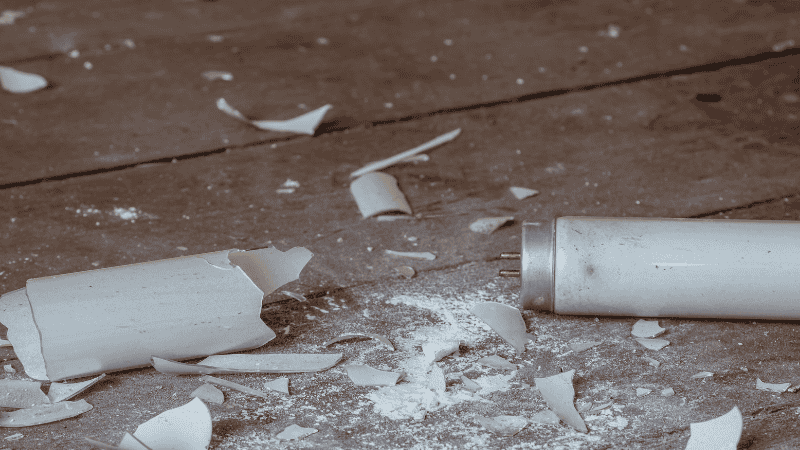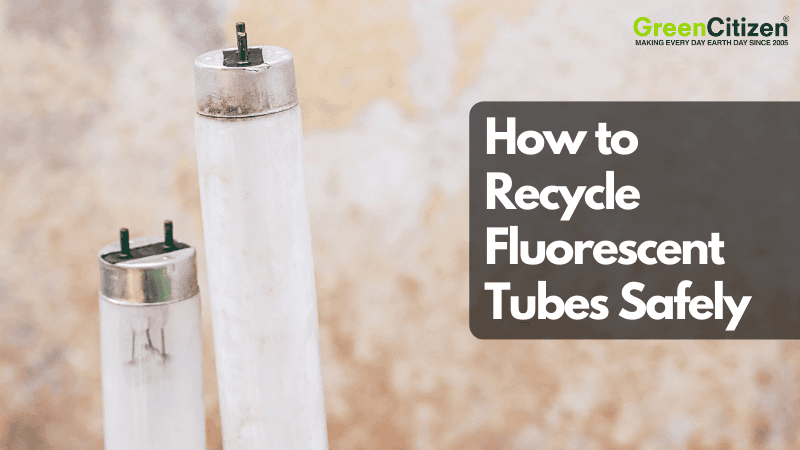Every year, over 600 million fluorescent tubes are discarded in the U.S.—and many end up leaking toxic mercury into landfills, soil, and water.
These long light tubes may seem harmless, but they contain mercury vapor, fragile glass, and phosphor powder—all of which make them hazardous household waste. Tossing them in the trash isn’t just unsafe—it’s often illegal in states like California and Vermont, where improper fluorescent tube disposal can lead to fines.
So, how do you recycle fluorescent tubes safely and legally?
This guide explains how to recycle fluorescent tubes, where to take them (including retail drop-off locations), and what to do if one breaks. You’ll get clear, actionable steps to protect yourself—and the planet.
Key Takeaway: How to Recycle Fluorescent Tubes the Right Way
Fluorescent tubes must be recycled through certified drop-off sites, retail take-back programs, or mail-in kits—never tossed in the trash. Due to their mercury content, improper disposal is illegal in many states and hazardous to health. Use tools like GreenCitizen’s Green Directory to find safe, local recycling options near you.
Can You Recycle Fluorescent Tubes?
Yes, fluorescent tubes can be recycled, but not through your curbside bin. Because they contain mercury, they’re classified as hazardous waste and require specialized recycling. Many states prohibit throwing them in the trash, making recycling the safest and most legal option.
Fluorescent tubes contain mercury vapor, phosphor coatings, and glass, all of which can be harmful if not handled properly. That’s why fluorescent tube disposal is regulated in most parts of the U.S., including California, Maine, and Vermont.
You’ll need to take them to a hazardous waste facility, certified recycler, or a retail drop-off point like Home Depot or Lowe’s—though availability varies by location. Always check local guidelines before discarding fluorescent bulbs.
Recycling fluorescent tubes not only keeps toxic materials out of landfills but also allows the recovery of valuable materials like aluminum end caps and recyclable glass.
How to Recycle Fluorescent Tubes: Step-by-Step Tube Light Recycling Guide
Recycling fluorescent tubes the right way helps prevent mercury pollution and keeps hazardous materials out of landfills.
Follow these steps to safely prepare and recycle your tubes, whether they’re intact or broken.

How to Prepare Fluorescent Tubes for Recycling
Fluorescent tubes are fragile and packed with mercury-containing powder, so treat them like hazardous cargo. Always wear gloves and a mask to avoid cuts or inhaling toxic dust.
For intact tubes, wrap them individually in stiff paper or bubble wrap—skip the tape, as friction holds the wrap in place.
If a tube shatters, never vacuum the debris—this spreads mercury vapor. Instead, sweep glass fragments and phosphor powder into a sealed container (like a glass jar) or a sturdy plastic bag. Label it clearly: “Broken Fluorescent – Contains Mercury.”
Store tubes upright in their original packaging during transport to minimize accidents.
How To Dispose of Fluorescent Tubes
Recycling fluorescent tubes isn’t complicated—just choose the method that fits your needs:
Option 1: Local Recycling Centers
Search “fluorescent tube drop-off near me” to find Household Hazardous Waste (HHW) collection sites, which are EPA-approved for safe disposal. For example, Austin Resource Recovery in Texas accepts tubes year-round for free.
You should try our Green Directory to find the nearby fluorescent tube recycling centers. Just enter your location and set the search radius. You’ll find all nearby responsible recyclers that can help you properly dispose of light bulbs.
⚠️ Pro tip: Call ahead—some centers charge small fees or require appointments.
Option 2: Retail Take-Back Programs
Major U.S. retailers like Home Depot and Lowe’s often accept fluorescent tubes at select locations. However, policies vary. Ace Hardware allows up to 10 tubes per visit, while others restrict quantities. Check their websites for details before hauling your stash.
Option 3: Mail-In Recycling Kits
For rural areas or bulk disposal (think office buildings!), brands like LampMaster and EcoLights offer pre-labeled recycling kits. Pay 20 to 50 bucks, pack your tubes in the provided box, and ship via UPS. You’ll even get a recycling certificate for your records!
What NOT to Do when Fluorescent Bulbs
Avoid these mistakes to dodge fines and environmental harm:
- Trash or Curbside Bins: Tubes crack in garbage trucks, releasing mercury into landfills.
- Mix with Regular Bulbs: Fluorescent tubes aren’t like LEDs or incandescents—they’re hazardous waste.
- Ignore Broken CFLs: Those spiral bulbs? They’re just as dangerous. Seal fragments immediately.
Heads up: Even if your city’s guidelines seem vague, most U.S. states ban fluorescent tubes from regular trash. When in doubt, recycle!
Where to Recycle Fluorescent Tubes Near You

You can recycle fluorescent tubes at Household Hazardous Waste (HHW) collection sites, participating retail stores, and through manufacturer take-back programs. These options ensure safe disposal of mercury-containing light tubes and help you comply with local hazardous waste laws.
Find Fluorescent Tube Recycling Locations in the U.S.
- Search “fluorescent tube recycling near me” to find local HHW drop-off events and permanent collection centers.
- California, Minnesota, and Vermont prohibit fluorescent tube disposal in landfills. Fines for improper disposal can reach $25,000.
- Los Angeles County hosts quarterly HHW events; most counties have similar programs.
➡️ Use GreenCitizen’s Green Directory to instantly find certified fluorescent light bulb recyclers near you by ZIP code.
Retail Store Drop-Off Programs
- Home Depot and Lowe’s: Accept tubes at select stores (always call ahead).
- Ace Hardware: Allows small quantities per visit.
- Availability varies, so check your local store’s recycling policy before heading out.
Fluorescent Tube Recycling Outside the U.S.
Outside the U.S., recycling systems vary but are equally critical:
- European Union: Follow the WEEE Directive—retailers must take back old tubes for free.
- Canada: Use Product Care Recycling’s province-specific programs.
- Australia: Check FluoroCycle for commercial and household solutions.
Pro Tip: Search “fluorescent tube recycling [Your Country]” to find local partners. Major cities like London and Toronto often host HHW depots year-round.
Manufacturer Take-Back Programs
Many bulb manufacturers simplify recycling through mail-back services:
- Philips: Offers prepaid recycling kits via LightRec.
- Sylvania: Partners with RecyclePak for U.S. households.
- GE: Provides bulk disposal solutions for businesses.
These programs often include pre-labeled shipping boxes, making it as easy as mailing a package.
What to Do If a Fluorescent Tube Breaks: Safe Cleanup Guide
If a fluorescent light bulb or tube breaks, it releases mercury vapor, which can be harmful to breathe. Follow these steps to safely clean up a broken fluorescent bulb and prevent mercury exposure.
Accidents happen—here’s how to protect yourself and others from mercury exposure.
Step 1: Evacuate & Ventilate
- Immediately clear people and pets from the room.
- Open windows and doors to air out the space for at least 15 minutes.
- Turn off any HVAC systems to avoid spreading vapor.
Step 2: Gear Up
- Wear gloves and a face mask to avoid skin contact and inhalation.
- Do not vacuum the area—this spreads toxic particles.
Step 3: Clean Strategically
- Use stiff paper to scoop glass shards.
- Wipe residue with damp paper towels (never dry-sweep!).
- For carpets: Follow the EPA’s CFL Cleanup Guide to clean up mercury-containing lamps.
Step 4: Dispose Properly
- Place all materials—glass, powder, and cleaning wipes—into a sealed glass jar or a zippered plastic bag.
- Label the container: “Broken Fluorescent – Contains Mercury.”
- Take it to a certified Household Hazardous Waste (HHW) facility as soon as possible.
Is It Illegal to Throw Fluorescent Tubes in the Trash?

Yes, throwing fluorescent tubes in the trash is illegal in many U.S. states. These bulbs contain mercury and are classified as hazardous waste, making curbside disposal both unsafe and subject to fines.
Legal Penalties for Improper Fluorescent Tube Disposal
The Resource Conservation and Recovery Act (RCRA) regulates hazardous waste, including mercury-containing lamps. Businesses (e.g., offices, schools) must recycle tubes via certified handlers or face federal penalties.
Households are exempt from federal fines but must still follow state/local rules.
State-Level Penalties
- California: Fines up to $25,000 for dumping fluorescent bulbs in trash (DTSC regulations).
- Massachusetts: Bans all mercury-containing materials (including tubes) from landfills. Violators pay $100 to $2,000.
- Minnesota: Requires recycling for all fluorescent light bulbs; fines start at $50 per bulb.
- Vermont: Prohibits household hazardous waste in trash; penalties apply to residents and businesses.
Check your state’s Department of Environmental Quality (DEQ) website for specifics.
Why Fluorescent Tube Disposal Is Regulated Differently
| Bulb Type | Contains Mercury? | Trash Legal? |
|---|---|---|
| Fluorescent Tubes | ✅ Yes | 🚫 Illegal |
| CFLs (Spiral Bulbs) | ✅ Yes | 🚫 Illegal |
| Neon Lights | ✅ Often | 🚫 Illegal |
| LEDs | ❌ No | ✅ Allowed (but recyclable) |
| Incandescents | ❌ No | ✅ Allowed (but recyclable) |
Consequences Beyond Fines
- Environmental Harm: Mercury from used bulbs contaminates water, soil, and wildlife.
- Health Risks: Broken glass and mercury exposure endanger sanitation workers and communities.
- Legal Liability: Landlords, businesses, or property owners can be sued for improper waste disposal.
How to Avoid Penalties
- Recycle, Don’t Trash: Use household hazardous waste programs, retailers like Home Depot, or mail-in kits.
- Handle with Care: Follow safe handling protocols for broken fluorescents.
- Educate Others: Share cleanup steps and laws with neighbors, coworkers, or tenants.
Why Recycle Fluorescent Tubes?
A single fluorescent tube hides a toxic time bomb: just 4-5 milligrams of mercury—enough to contaminate 6,000 gallons of water (roughly an Olympic-sized pool!). When crushed in landfills, this mercury transforms into harmful vapor or seeps into groundwater, poisoning aquatic life and, eventually, our food chain.
For humans, exposure risks neurological damage, especially in children and pregnant women, linked to memory loss, tremors, and developmental delays.
The EPA classifies fluorescent tubes as hazardous waste for this reason, and states like California and Massachusetts impose fines up to $25,000 for improper disposal. Yet many people toss these bulbs into regular household trash, unaware that shattered glass releases mercury into landfills, creating a silent threat.
Unlike safer LEDs or incandescents, fluorescent tubes demand special handling. Ignoring this risks both health and legal consequences.
Recycling isn’t just eco-friendly—it’s a shield against pollution. Ready to learn how to dispose of them safely?
Protect Your Community—Recycle Fluorescent Tubes & Switch to LEDs
Every fluorescent tube recycled is a step toward curbing mercury pollution, safeguarding human health, and preserving ecosystems. While recycling remains critical, the simplest long-term solution? Switch to LED bulbs. LEDs last longer, slash energy bills, and contain zero mercury—no hazardous cleanup or complex disposal required.
But for your existing fluorescent tubes, don’t risk fines or environmental harm. Recycle responsibly using GreenCitizen’s Green Directory, your go-to tool for finding certified recycling centers near you. In seconds, search by zip code to locate your nearest recycling option.
Join thousands who’ve already made the switch to sustainability—because safe disposal isn’t just a choice, it’s a responsibility.
